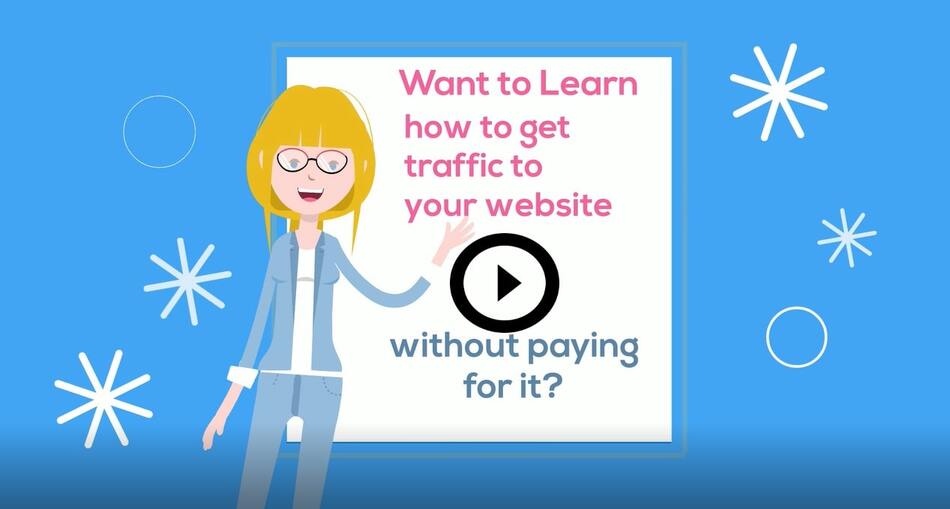Ask any business owner what they want, and their responses will all be the same. They want more paying customers.
The more quality traffic to your website, the better your chances of converting visitors into customers.
Your company website is the online foundation of your brand. It is also the first impression visitors to your site get of your business.
Even if your website provides valuable and relevant information and has proven it can drive sales, it will not matter if you are not getting enough traffic to your site.
Below are several strategies to drive traffic and attract your target audience without having to pay for it.
Focus on Getting Direct Traffic
How likely are your customers to remember your brand name or domain? Who needs search engines when your customers can type in your URL directly?
Your brand name and domain need to be memorable and easy to spell. No one needs to use a search engine to find eBay, Etsy, or Amazon.
Choose a high-ranking domain from a broker. Here are some reasons a premium domain name should be a consideration:
- Bypass search engines through branded search (direct traffic)
- Establish rank more quickly than one from the sandbox
- An existing high quality link profile
Links pointed to premium domains usually stay live well after the domain is sold by the original owner. And if the links still do exist, (say from esteemed publications), there is potential for referral traffic as well.
A premium domain purchase should be either distinctive or descriptive. For example, Amazon.com is distinctive and Shoes.com is descriptive.
Follow Technical SEO Best Practices
Technical SEO is the process by which you optimize your website for Google’s crawlers. It plays a vital role in getting traffic to your site.
If Google cannot find, index, and crawl your site, it will not rank. Period. Technical SEO focuses more on your site’s infrastructure than its content. Below are several best practices to follow:
- Optimize your website’s URL structure, robots.txt file, and 404 pages
- Use logical, intuitive, and easy navigation
- Install an SSL certificate
- Include an XML sitemap
- Use 301 redirects
- Ensure your site is mobile-responsive
- Compress and optimize images for faster loading times
- Make sure your website loads quickly
For more information about technical SEO, read Backlinko’s Definitive Guide.
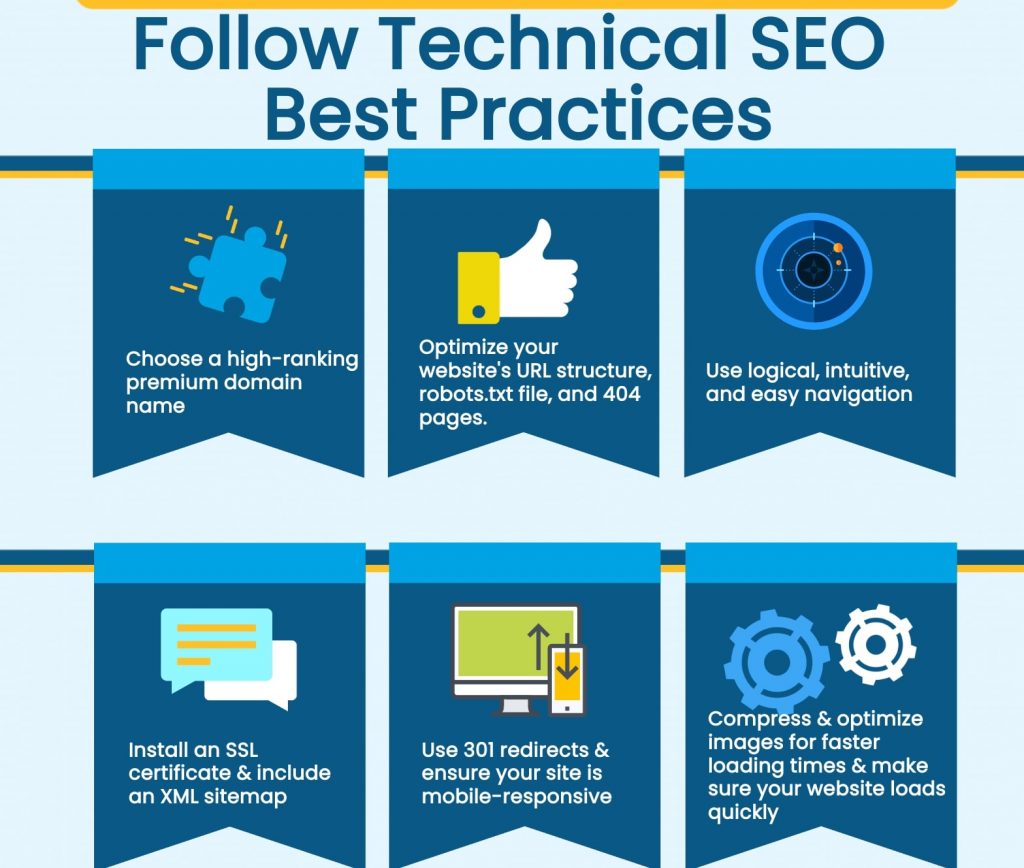
Focus on Creating Amazing Content
Search engines prefer sites with current, high-quality content. One of the best ways to regularly publish updated content on your website is to include a blog.
Spend more time on the quality of the content you write, not just on the quantity. If your blog posts are valuable, engaging, and useful to your target market, they will attract traffic and links to your site.
Write content that answers the questions your potential customers are searching for with relevant keyword phrases. Your site is more likely to show up in a query for those looking for answers.
Attract traffic to your website with these content suggestions:
- Interviews with industry leaders
- Case studies of customers who have achieved success using your product or service
- Latest and breaking news updates
- Solutions to common problems faced by those in your niche
- Humorous content to keep your audience engaged
- How to or tutorials on relevant industry topics
- Product or service comparisons
Post blog topics that readers are searching for and love. Keep them engaged and increase your organic traffic.
Leverage Social Media
Be proactive by using social media channels to promote your content to your target audience and increase traffic to your site.
Although, according to some experts and Google, the number of social media likes and shares does not directly affect page rank. Social media activity does drive referral traffic to your website.
Referral traffic comes from links on another website. Use Google Analytics to see how much referral traffic you are getting from each social media platform you use.
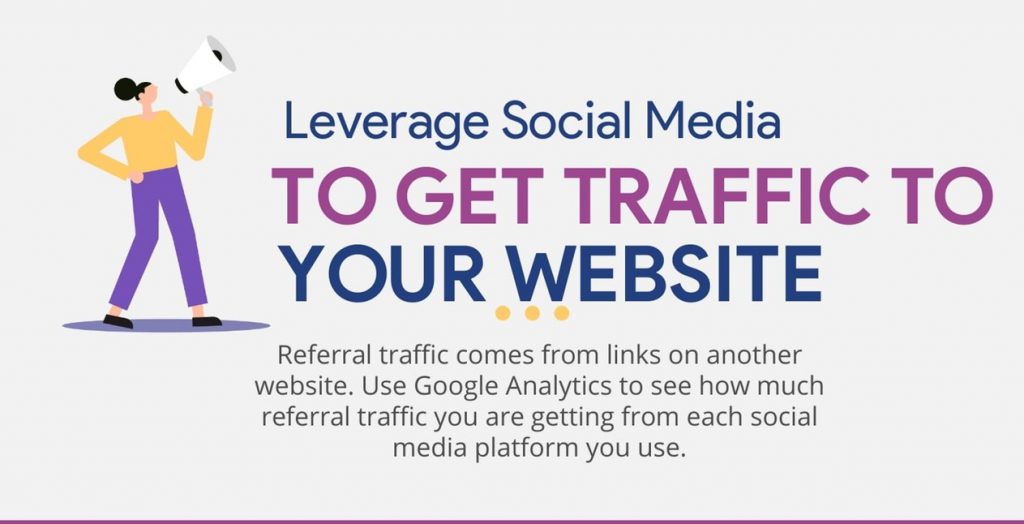
How can you use social media to boost your website traffic?
- Optimize each social media profile
- Share posts or links consistently
- Create viral content such as memes
- Identify and contact the top social media influencers in your niche
- Research and analyze competitors’ social media strategies to create your own
- Run contests, quizzes, and polls to engage your audience
- Focus on sharing unique and compelling visual content
Monitor and listen to meaningful conversations about your brand on the web with tools like Mention. Then filter and analyze data about your brand and your competitors, gain valuable insights, and manage your social media campaigns.
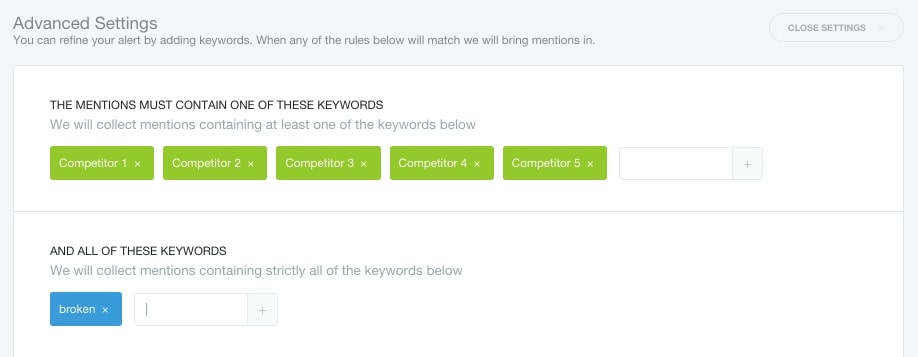
Be persistent and patient and focus on the customer to use social media the right way and reap its benefits in the long term.
Add Social Media Sharing Buttons to Your Website
Do not make it difficult for others to share your content. Instead, use social media sharing buttons to make it easier to share. For WordPress users, there are numerous social media sharing plugins from which to choose.
Most of the plugins offer free and premium versions. They also enable you to customize options such as which social sites to share, how and where to place them on each post, and whether to show share counts or not.
The most popular social media sites such as Twitter, Facebook, Pinterest, and LinkedIn, include a backlink to your post.
Use Compelling Headlines
Headlines are the most critical components of your content. Even if your blog content is comprehensive and valuable, few will read it if your headline is not irresistible.
Take the time you need to craft a headline that people will want to click on. Remember to be customer-focused and make it all about them.
For example, a headline such as: “Check out my review of product X” makes it sound like you are asking readers to do you a favor.
Instead, a headline like: “Do not buy product X until you read this” suggests explicitly that what you are providing is of value to the reader by making it about them.
Other tips for writing awesome headlines include:
- Including lists, statistics, and numbers
- Educating those interested in learning how to do something
- Demonstrating your value to the reader
- Using strong verbs and adjectives
- Asking questions
- Not using more than 70 characters
- Clearly defining what is covered in the blog post
- Addressing pain points and your solution to them
Take the time you need to focus on writing the best headline possible. If it is not compelling enough, they won’t read your post.
Using a tool such as CoSchedule’s Free Headline Analyzer, you can craft headlines that drive shares and traffic.
Write Evergreen Content
While timely breaking news updates will help drive traffic to your website, their relevance has a shelf life.
On the other hand, evergreen content will remain relevant long after it is published. Examples of evergreen content include:
- Reference guides
- Product or service reviews
- Frequently asked questions
- How-to guides or tutorials
Publishing evergreen blog post content will bring in a steady stream of traffic from search, social shares, and leads over time.
Expand Your Reach with Guest Posting
By providing content on relevant, high-authority websites that accept guest posts, you can maximize your content strategy.
Although it is not easy to get a post accepted on a valuable brand’s blog, it is well worth the effort. Some of the benefits you receive include:
- Exposure to a broader audience
- Expanding your online network
- Generating quality backlinks
- Increasing brand awareness
- Boosting your authority
Getting your content accepted and published on a reputable site can help build awareness for your brand and increase traffic to your blog.
Most sites that accept guest posts will give you a short bio section that often includes a link back to your site.
Ensure that any content you submit to high-profile blogs is of the highest caliber, not spammy, and not self-promotional.
The goal is to offer value to the site where you are pitching an article. In turn, that website can share value with its audience.
Write an Expert Roundup Post
Collect quotes from experts and include them in an article to create an expert roundup post. Increase engagement and social shares with posts such as these on Bloggers Ideas.
Expert roundups generate traffic because:
- The content is provided by experts in your niche who will likely share it with their audience
- They are structured like listicles, which are known to perform well in SEO
- The well-known professionals included in your roundup will attract more visitors looking for valuable insights from those in the know
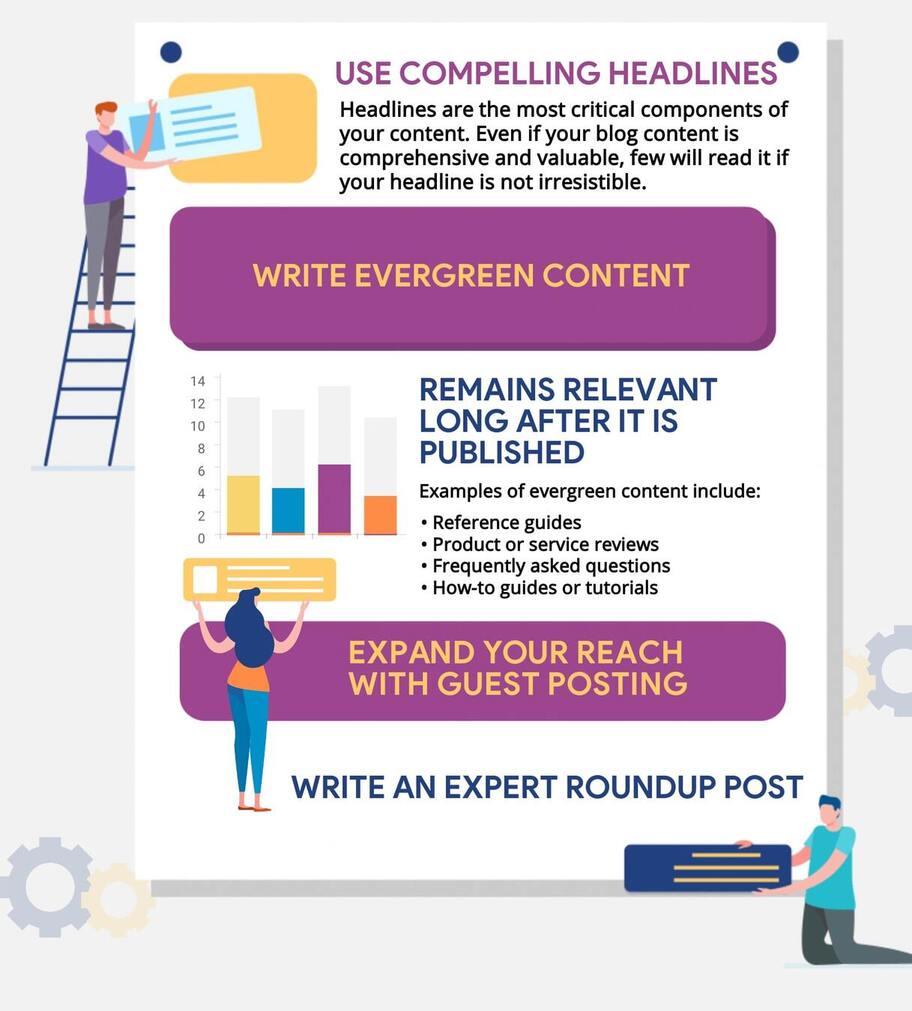
Give Away Something of Value
Many websites use lead magnets for lead generation to grow their email list and increase website traffic.
Types of digital content you might want to consider include:
- Design templates
- Tutorials or how-to videos or articles
- An eBook or free relevant report
By offering something free that is perceived as valuable, you are enticing people to visit your website to grab the offer.
If you are using it as a lead magnet, you can request contact information in exchange for the giveaway.
Use Internal Links
Your link profile is measured by how many sites link back to you and your internal linking structure. When writing new blog posts for your website, look for opportunities to link to other relevant content on your site.
Internal linking provides a helpful experience for users, improves SEO ranking, and increases traffic to your website.
Use a Variety of Formats and Lengths
There is no magic bullet for content marketing success. Different people prefer and gravitate towards information in various formats and lengths.
Keep your website appealing to different kinds of learners and the preferences of your target market. Write some long-form posts for those who like to read in-depth articles.
Include some shorter content for readers who do not have the time or inclination to read a long blog post.
Include engaging visual content such as infographics, images, and videos for users who prefer this type of content.
Use a variety of formats and lengths of written content for maximum impact.
Update Old or Outdated Blog Posts
Instead of recreating the wheel with new content, look at your older posts. If you have been blogging for a long time, the chances are excellent that you will have many posts you can update and bring back to life.
Start by looking at your blog posts that are currently not ranking well in Google. Some of the ways you can improve them include:
- Updating any outdated information, especially statistics
- Adding visuals such as screenshots, images, and videos
- Spicing up the introduction to entice more readers
- Increasing your word count by adding additional relevant content
- Adding internal and external links from related posts
- Improving readability by using bullet points and shorter paragraphs
Another option is to merge two short older posts on a similar topic into one. Republish the older posts and promote them again as new content.
Get More Bang for Your Buck
Extract as much value as possible from one piece of content by repurposing it into different formats for maximum effectiveness.
See a few ideas below on how to repurpose your content:
- Convert blog posts into downloadable guides
- Create eBooks or blog posts from interviews with experts in your niche
- Turn webinars into shorter shareable videos
- Record podcasts from blog posts
Finding new ways to reuse existing content is useful for reaching new audiences on different mediums. Make the most out of your content by breathing new life into older content.
Manage Your Online Reputation
Are you wondering how your online reputation can get traffic to your website? Since 91% of consumers look at online reviews before making a purchase, those same people are looking at your brand’s reputation.
There are online review sites such as Google My Business, Yelp, and Manta that will drive referral traffic to your website with minimal effort on your part.
Take advantage of the ability to post weekly updates on Google My Business. Uploading coupons, product images, and video reviews and testimonials can increase your sales.
Managing your reputation from third party sites increases your online visibility and rankings in the search engines.
The primary review site brands, such as those listed above, already appear high in search engine results pages. Being included on their sites gives your website a boost.
Monitor the reviews you receive. Do not panic over negative reviews. People understand that no one brand can please everyone all the time.
It would be a mistake to ignore a complaint. Instead, respond professionally and try to resolve the customer’s issue or concern.
If you cannot do so, other potential customers will see your response to a negative review. Many will also evaluate your brand on how you handle difficult customers.
Create a Plan and Follow it
Everything you do on the web benefits from being consistent. And driving traffic to your site is no exception.
Consistency in your content marketing lets Google see your site as a reliable source of information and keeps your brand relevant to your audience.
It is better to publish high-quality blog posts less frequently but on a regular schedule than lesser quality content posted randomly.
An easy way to be consistent is to use a project management system for tracking progress and a content calendar for planning.
There are several free project management tools, such as Trello, ClickUp , and Wrike. The free tools have premium versions, too, if you need more features and functionality.
You can download free content marketing calendar templates in various formats from Templates.net to help you start with a plan.
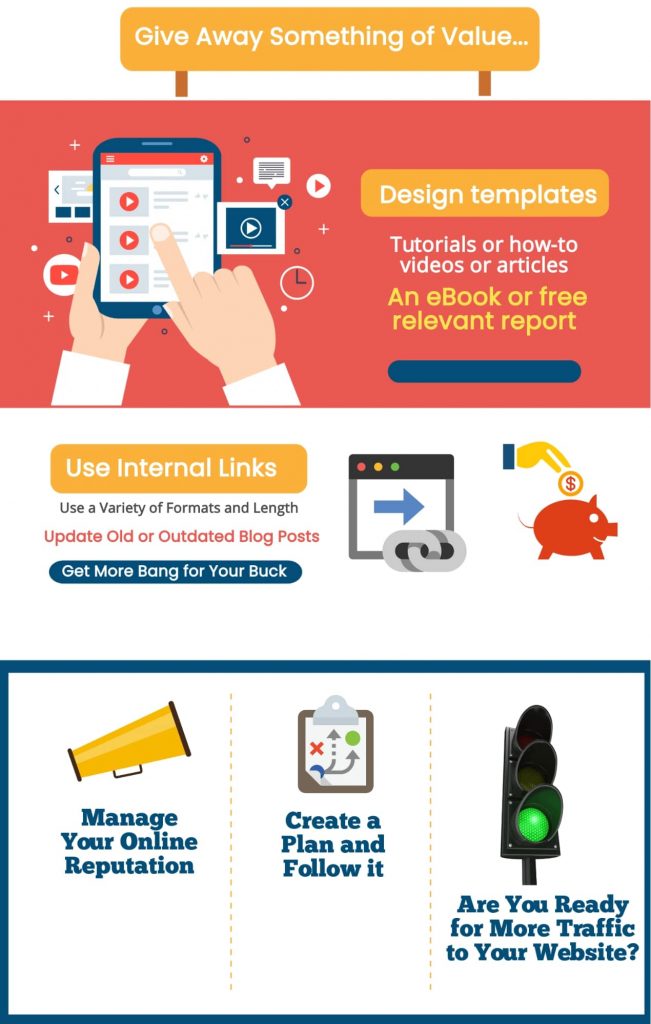
Are You Ready for More Traffic to Your Website?
The above list is by no means exhaustive, but it is enough to get you started. Try a few and measure their effect on the amount of traffic you receive.
If you see an increase, continue using that tactic. Try a few more and measure the performance. Start slowly and be sure to measure and track all your efforts.
Double down on the most successful strategies and discontinue those that are ineffective. Use the tips above to increase traffic to your website without having to pay for it.
